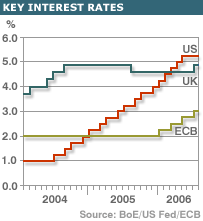Wanamaker waste
IN TERMS of efficiency, if not size, the advertising industry is only now starting to grow out of its century-long infancy, which might be called “the Wanamaker era”. It was John Wanamaker, a devoutly Christian merchant from Philadelphia, who in the 1870s not only invented department stores and price tags (to eliminate haggling, since everybody should be equal before God and price), but also became the first modern advertiser when he bought space in newspapers to promote his stores. He went about it in a Christian way, neither advertising on Sundays nor fibbing (thus minting the concept of “truth in advertising”). And, with his precise business mind, he expounded a witticism that has ever since seemed like an economic law: “Half the money I spend on advertising is wasted,” he said. “The trouble is, I don't know which half.”
And the same article provides some interesting insights on how the current medium (With AdWords' Pay-per-click and Snap.com's Pay-per-buy) try to eliminate the Wanamaker Waste:
Rishad Tobaccowala, the “chief innovation officer” of Publicis, one of the world's biggest advertising groups, and boss of Denuo, a Chicago-based unit within Publicis with the job of probing the limits of new advertising models, likens traditional Wanamaker-era advertising to “an atom bomb dropped on a big city.” The best example is the 30-second spot on broadcast television. An independent firm (such as Nielsen, in America) estimates how many television sets are tuned to a given channel at a given time. Advertisers then pay a rate, called CPM (cost per thousand), for the right to expose the implied audience to their spot. If Nielsen estimates that, say, 1m people (“the city”) are watching a show, an advertiser paying a CPM of $20 would fork out $20,000 for his commercial (“the atom bomb”).
By contrast, the new advertising models based on internet technologies amount to innovation. Instead of bombs, says Mr Tobaccowala, advertisers now “make lots of spearheads and then get people to impale themselves.” The idea is based on consumers themselves taking the initiative by showing up voluntarily and interacting with what they find online.
In its simplest form, this involves querying a search engine with keywords (“used cars”, say), then scanning the search results as well as the sponsored links from advertisers, and then clicking on one such link. In effect, the consumer has expressed an intention twice (first with his query, then with his click). The average cost to an advertiser from one such combination is 50 cents, which corresponds to a CPM of $500; by contrast, the average CPM in traditional (“exposure”) media is $20. A consumer's action, in other words, is 25 times as valuable as his exposure.
The person who deserves more credit than anybody else for this insight is Bill Gross, an internet entrepreneur with a kinetic mind and frenetic speech who in 1996 started Idealab, a sort of factory for inventions.
See the post on Bill Gross below.






